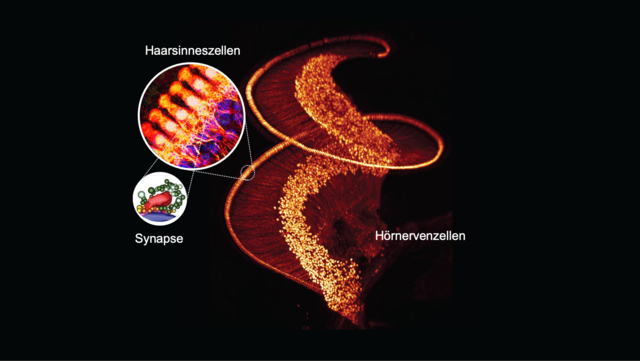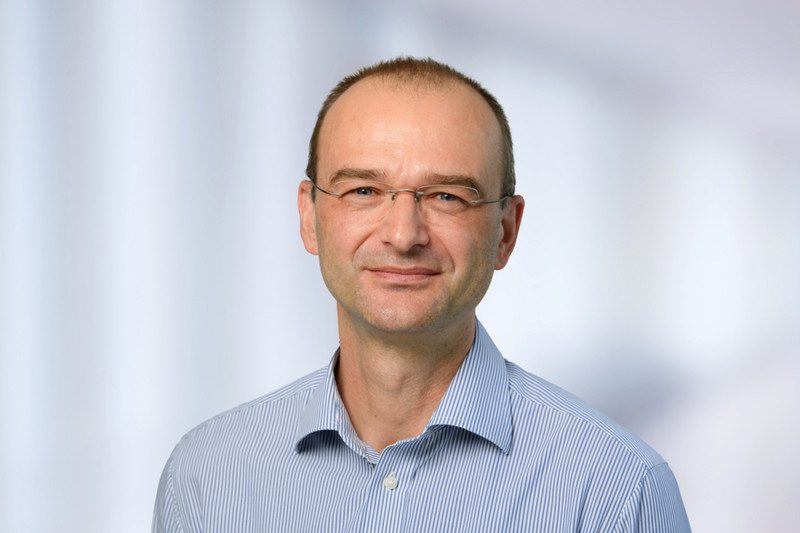European funding for excellent research on hearing
Tobias Moser, MD, Director of the Institute for Auditory Neuroscience at the University Medical Center Göttingen (UMG) was awarded an Advanced Grant of the European Research Council (ERC). The ERC supports his research project „Solving the dynamic range problem of hearing: deciphering and harness- ing cochlear mechanisms of sound intensity coding (DynaHear)“ over five years with 2,5 million euros.
”’DynaHear’ promises to fundamentally improve our understanding of the coding of sound intensities in our ears and of what goes wrong in hearing impairment”, says Tobias Moser.
PROJECT DYNAHEAR
Our sense of hearing processes acoustic signals that differ in sound pressure by more than six orders of magnitude. This enables the perception of auditory impressions as different as rustling of leaves and a roaring jet engine. This amazing function of the ear can be compared to trying to measure body temperature and the temperature inside the sun with the same thermometer. While the presynaptic inner hair cells (IHCs) in the cochlea cover the entire dynamic range of audible sound intensities, each downstream spiral ganglion neuron (SGN) encodes only a fraction. The intensity information is then reconstructed by the brain. This so-called “dynamic range problem” of hearing is known for decades, but how sound intensity information is decomposed into different neural pathways remains elusive.
In vivo recordings discovered a wide functional diversity of postynaptic SGNs that also exibit distinct molecular profiles. Ensembles of these different neurons collectively encode the intensity for a given sound frequency. The aim of the project is to test the hypothesis that an interplay of synaptic heterogeneity, molecularly distinct subtypes of SGNs, and efferent modulation serves the neuronal decomposition of sound intensity information. Using a multiscale and multidisciplinary research approach, Moser and his team will elucidate the molecular underpinnings of synaptic heterogeneity, decipher the mechanisms establishing such heterogeneity, and relate them to functional SGN diversity. To this end, the scientists combine state-of-the-art multimodal imaging approaches, optogenetics and modeling techniques.
Otolaryngologist and neuroscientist Tobias Moser is an international leader in research into the physiology and pathophysiology of the inner ear. As part of collaborative research networks at the Göttingen Campus, he investigates the elementary, lightning-fast and highly complex processes of synaptic sound coding as well as the molecular and cellular basis of hearing loss. Since 2008, he and his research teams have also pioneered the establishment of the optogenetic cochlear implant to restore hearing. Moser was initiator and until 2021 spokesperson of the Collaborative Research Center SFB 889 "Cellular Mechanisms of Sensory Processing" and serves the Cluster of Excellence "Multiscale Bioimaging: From Molecular Machines to Networks of Excitable Cells" (MBExC) as spokesperson. In addition to the Institute for Auditory Neuroscience at the UMG, he leads a research group as a Max Planck Fellow at the Max Planck Institute for Multidisciplinary Sciences (MPI-NAT) in Göttingen, and also has a joint appointment with the German Primate Center (DPZ), Leibniz Institute for Primate Research.
Mosers work has already been recognized with various awards. Among others, he received an ERC Advanced Grant from the European Union in 2015 as well as the Gottfried Wilhelm Leibniz Prize 2015 from the German Research Foundation, the Ernst Jung Prize in 2017, the Guyot Prize 2019 as well as the "Great Science Prize 2020" from the French Fondation Pour l'Audition (FPA).
Tobias Moser, born 1968, completed his medical studies in Leipzig and Jena/Erfurt with a doctorate in medicine in 1995. From 1994 to 1997 he worked as a post-doctoral fellow under Nobel Prize winner Prof. Dr. Erwin Neher at the Max Planck Institute for Biophysical Chemistry, Göttingen. There, he was head of a junior research group from 1997 to 2001. At the same time, he completed a specialist training course in ear, nose and throat medicine at the Department of Otorhinolaryngology at the University Medical Center Göttingen. In 2003, he habilitated, was appointed W2 professor in 2005, and finally became a W3 professor for auditory neuroscience at the UMG Department of Otorhinolaryngology in 2007. Since 2015 he is director of the Institute for Auditorial Neuroscience at the UMG.
ABOUT THE ERC ADVANCED GRANT
With the ERC Advanced Grant, the European Union supports outstanding, already established scientists in projects that promise groundbreaking new insights. A list of all awardees of this round can be found at:
https://erc.europa.eu/sites/default/files/document/file/erc-2021-adg-results-all-domains.pdf
(Press release of the University Medical Center Göttingen (UMG))


